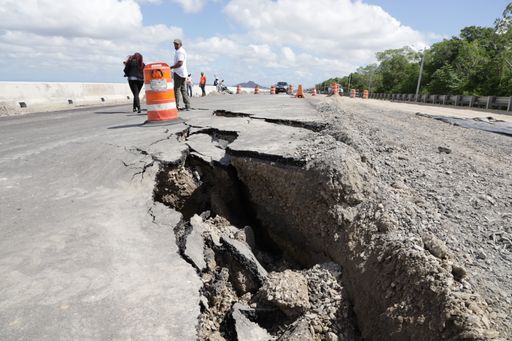(Trinidad Guardian) Works Minister Rohan Sinanan says he is awaiting a report following the partial collapse of the $280 million Mosquito Creek segment of the Solomon Hochoy Highway Extension project.
Speaking to Guardian Media on Monday, Sinanan said the National Infrastructure Development Corporation as well as consultants, were continuing to do investigations to determine why the highway collapsed.
When Guardian Media visited, further slippage was seen along the road. Part of the collapsed road was covered with plastic but the newer cracks remained visible. Frothy brackish water could be seen inside the cracks which spanned about 400 feet of roadway.
There were also cracks on the revetment wall, running alongside the coast. Heavy stones placed to break the onslaught of waves were lower than when they were first laid.
Asked to comment Sinanan said, “NIDCO put out a statement. They are investigating along with consultants. Once investigations are complete and I get a report, I will be able to tell you more.”
In its statement, NIDCO said the exact cause of the road instability was under investigation.
Engineers on the project had noted that the Mosquito Creek area was at the highest risk of failure during construction due to the prevailing geotechnical conditions of the soil, NIDCO added.
“Continuous construction loads and the traversing of heavy construction equipment, coupled with unfinished construction works, may have caused the instability,” the company said.
NIDCO explained that its consulting engineer AECOM will develop designs to undertake repairs to the failed area to prevent any disruption to traffic.
An official from AECOM who was on the site declined to comment. Engineers from NIDCO as well as other quality control personnel also declined comment.
But former NIDCO consultant and president of the South Oropouche Riverine Flood Action Group Edward Moodie told CNC3 News that the highway was built on marshlands. He said the first plan was to build a causeway but this was not done
“They decided not to go that way. They built on silted land where there is marshland going very deep underground. When they opened the white bridge at Paria Suites, that entire area started to sink and they condemned it and dug it out. They brought in geofoam. But in this area, they used geotextile. When this road was initially constructed they used teak planks to stabilise the road knowing that it was heavy marshlands,” Moodie said.
He added, “There is absolutely no drainage for two kilometres from the mangrove going into the seas. Nature intended that the mangrove be drained and should be flooded back with seawater. They decided to stop that. There is a river in the middle of the highway that comes to a dead stop when it hits the highway.”
He said, “ The water from the sea is penetrating, water from the mangroves is penetrating. When they vibrate with their equipment, they break the cohesive forces and the surface tension. Everything is loose and is giving back to nature.”
Moodie said this was not the first time that the road had failed.
“There is a place in Jangal that will also fail. The only thing that will help here is deep piles. This wall, built as a revetment wall has no footing for the walls, now the wall is bent and is caving into the sea,” Moodie added.
He said the consultants who did soil testing, as well as Nidco should be held accountable for wasting taxpayers money.





